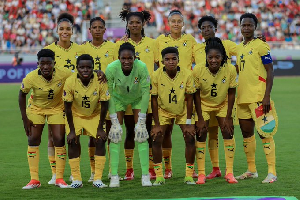Business News of Thursday, 27 August 2020
Source: www.ghanaweb.com
FULL TEXT: Second Deputy BoG Governor speaks on Corporate Insolvency and Restructuring Act
Members of the Governing Council and Executives of GARIA
Distinguished GARIA Members,
Distinguished Resource Persons Invited Guests,
Ladies and Gentlemen Good morning. I bring you warm greetings and felicitations from Governor Ernest Addison and the entire management team of the Bank of Ghana.
I am truly humbled to have been called upon to give the keynote address at this very important gathering. I am in the midst of giants in the fields of law, accounting, banking and insolvency, some of whom are my learned seniors at the Bar. I pay tribute to the tireless efforts of the Governing Council members and all members of GARIA who have over the years remained committed to the vision of the founding members of GARIA.
GARIA’s significant role in the crafting and promulgation of key pieces of legislation such as the Companies Act 2019 (Act 992) and the Corporate Insolvency and Restructuring Act, 2020 (Act 1015) is no mean achievement, and is a testament to the dynamic role that it has played in recent times in helping to modernize the foundations of our market-based economy.
It is against this backdrop that the Bank of Ghana is delighted to be associated with this sensitization webinar on the Corporate Insolvency and Restructuring Act, 2020 (Act 1015). The importance of this Act, particularly at this time, cannot be overemphasized. The current COVID19 pandemic has unleashed what is thought to be the worst global economic downturn since the Great Depression of the 1930s.
The economic impact of the pandemic on firms and households in developed and developing countries alike, is unprecedented owing to reduced demand for products and services, disruptions to global supply 2 chains, and limited access to financial markets.
The attendant job losses and personal and corporate distress situations have led to a deterioration in the quality of loan assets held by banks around the world, threatening their own solvency in some cases. Policy makers around the world are working hard to reduce the economic hardship from the pandemic on businesses and households, with stimulus packages that have included unemployment benefits, small business loans, and other cash transfers, while measures put in place by central banks and regulators have also helped to improve liquidity in financial markets.
Some jurisdictions have also introduced amendments to their insolvency laws (see Australia’s Response Act 2020 for example) to help delay triggers for initiating insolvency proceedings and providing temporary relief to directors from liability for failure to prevent insolvent trading.
The Ghanaian economy has seen a significant slowdown since the onset of the pandemic, impacting negatively on businesses (especially micro, small and medium-sized) and households. The impact of the pandemic on the Ghanaian banking sector is also evident, as reflected in a dip in profitability due to lower net interest income and higher operating expenses, and an increase in credit risks owing to customers’ inability to service loans.
In addition to fiscal policy measures put in place by Government to cushion the impact of the pandemic on local businesses and households, the Bank of Ghana instituted a number of policy and regulatory interventions including a reduction in its monetary policy rate by one hundred and fifty basis points, a reduction in reserve requirements for banks and specialized deposit-taking institutions (SDIs), a reduction in the capital conservation buffer maintained by banks, a reduction in provisioning requirements for certain categories of loans, and the purchase of Government bonds to support economic recovery efforts.
These interventions have released significant liquidity into our banking system, which has allowed banks to account for restructured customer loans as a result of the pandemic, and grant new loans to customers in industries that have been at the forefront of helping to fight the pandemic.
We have recently issued guidance to the banks and SDIs on the accounting treatment of loan restructuring, classifications, provisioning, and expected credit losses, and prudential assessments of credit risk and capital ratios, as well as approaches to reporting to credit bureaus on loans that have been restructured, to help ensure standard reporting that does not unduly disadvantage the customer.
The Bank of Ghana’s recently-updated Composite Index of Economic Activity and consumer and business surveys show promise for a rebound in economic activity. The Ghanaian banking sector is also well-situated 3 to help finance the economic rebound we all hope for, thanks to earlier reforms instituted by the Bank of Ghana over the last three years that has strengthened the resilience of the sector.
These are encouraging indicators of the potential for a stronger, more self-reliant and resilient economy post-COVID, with the private sector leading. Given the Bank of Ghana’s statutory mandate to maintain stability in the general level of prices, promote economic growth and efficient operation of banking and credit systems in the country, and to promote financial stability, we recognize the benefits of a well-designed insolvency regime.
A robust corporate insolvency regime has a critical role to play in facilitating the post-COVID economic recovery, by helping to resolve the inevitable debt-overhang that will be one of the legacies of the pandemic, and by helping to reorganize viable but distressed firms while ensuring the exit of non-viable ones.
Act 1015 will therefore become very handy in the months and years ahead. If the recent banking sector cleanup is anything to go by, the orderly exit of non-viable institutions from the market place creates room for viable ones to thrive and support the economy better.
The clean-up exercise, which saw the revocation of licences of 420 banks, specialised deposit taking institutions, and non-bank financial institutions, was necessary to save the financial system from total collapse given the level of interconnectedness in the system.
Of the 420 institutions closed, 379 (9 banks, 23 savings and loans and 347 microfinance companies) are currently being resolved under the special resolution regime established under section 123 of the Banks and Specialised Deposit-Taking Institutions Act of 2016 (Act 930), while 41 NBFIs (39 microcredit institutions, one leasing company, and one remittance company) which were regulated under the NBFI Act of 2008 (Act 774) and are being resolved through liquidation under the now-repealed Bodies Corporate (Official Liquidations) Act, 1963 (Act 180) and Act 1015, following Bank of Ghana’s appointment of the Registrar of Companies as Official Liquidator pursuant to section 7 of the NBFI Act.
Please permit me to shed some light on Act 930, in particular, the framework it establishes for dealing with distressed and insolvent banks and SDIs. The provisions of Act 930 reflect international consensus that a special regime other than that often provided by corporate insolvency regimes, is needed to deal with weak financial institutions given the special nature of financial institutions.
Shareholders and Boards of banks and other deposit-taking institutions are expected to act quickly to address early signs of distress to mitigate the risk of failure which has ramifications not only for depositors but also for the stability of the entire 4 financial system and the economy as a whole.
The Basel Core Principles require bank supervisory authorities to have adequate legal powers to impose prompt corrective action on weak institutions to give them a chance of recovery within a reasonable timeframe, failing which they are required to take steps to resolve these institutions under a special resolution regime.
The international standard (as established by the Financial Stability Board in 2011) for resolving failed financial institutions, recommends that jurisdictions should have in place a resolution regime that provides the regulator or resolution authority a broad range of powers and options to resolve a financial institution that is no longer viable and has no reasonable prospect of becoming so, based on clear indicators of nonviability, and before a firm is balance-sheet insolvent and all equity has been fully wiped out.
The regime should provide options for stabilization and restructuring where feasible, as well as for orderly closure and winddown of all or parts of the firm’s business, in a manner that contains the potential systemic impact of their failure while they exit the market place.
Act 930, which was designed with technical assistance from the International Monetary Fund, provides the Bank of Ghana powers to require distressed banks or SDIs to take prompt corrective action to recover from capital or liquidity shortfalls, before they reach 50% of the minimum capital adequacy ratio required to be maintained, or before they default on their obligations to depositors and other creditors.
Once a bank or SDI’s capital falls below 50% of the minimum capital adequacy ratio required to be maintained by law, the Act considers such an institution to be “significantly undercapitalized” and authorizes the Bank of Ghana to place it in official administration, with a view to restructuring it and returning it to full capitalization. Once an institution has reached insolvency, Act 930 requires a mandatory revocation of licence and appointment of a receiver to take possession and control of the assets and liabilities of the failed institution, validate claims for payment in line with a hierarchy of claims that is specified under the Act, and complete winding up procedures and dissolution of the entity.
Both the official administrator and receiver appointed by the Bank of Ghana exercise their statutory powers under the Bank of Ghana’s exclusive oversight, ensuring that the resolution process promotes stability of the financial system.
The Act reflects a careful balance between the rights of shareholders that have failed to take the necessary actions to help their bank or SDI recover from distress, and the overriding public interest in ensuring that the risks posed by such an institution to depositors’ funds and the stability of the financial system as a whole, are mitigated. 5 Act 930 provides restructuring tools (such as mandatory mergers and acquisitions, partial transfers of assets and liabilities, recapitalisation by existing shareholders or by new investors without recourse to preemptive rights of shareholders, mandatory restructuring of claims – the so-called bail-in tool, and others), designed to help a bank or SDI in official administration return to full compliance with regulatory capital requirements.
It also provides for tools such as the “Purchase and Assumption” (“P & A”) tool in receivership, by which certain liabilities and assets of the failed institution may be transferred to an existing healthy financial institution or to a bridge bank or SDI to allow the assuming institution provide depositors access to their deposits and critical banking services, while the failed institution is wound down.
Thanks to this special resolution regime established under Act 930, the Bank of Ghana managed the orderly exit of nine banks and hundreds of smaller but no less systemic deposit-taking institutions, resulting in a more resilient banking sector and restoring trust and confidence in the system. Bank of Ghana’s latest financial soundness indicators show that while assets held by the banking sector in August 2017 when the reforms started stood at GH¢89.1 billion for a sector that had 36 banks, the total assets of the industry that now has 23 banks have increased significantly to GH¢138 billion at the end of the second quarter of 2020, with significant improvements in asset quality.
It is noteworthy that some of the now-defunct institutions had been diagnosed as far back as in 2015 to be significantly undercapitalized under the Bank of Ghana’s Asset Quality Review of the banking sector but not enough was done in time with the supervisory powers that were available to avert their inevitable demise.
This demonstrates the fact that restructuring options are only helpful when activated while there is still time, otherwise the slope to insolvency gets rather slippery and quickly too, leaving liquidation as the only option.
Now coming back to Act 1015 which is our focus today, we see it as an important addition to the framework for building a more buoyant economy, supported by a more efficient credit market. The recent banking sector cleanup has provided impetus for a more robust credit environment, as banks are now better capitalized and more liquid, than before.
Access to credit, however, remains a challenge to many economic actors due in part to legacy non-performing loans on the books of banks and SDIs given the challenges they continue to face in their loan recovery efforts. The Bank of Ghana has over the years put in place mechanisms such as the credit bureau regime to help banks and SDIs obtain information about borrowers’ credit behaviour as part of their credit underwriting processes.
It also promoted the enactment of the 6 Borrowers and Lenders Act 2008 (Act 773), to promote transparency in the terms and conditions pertaining to lending, to establish a collateral registration regime for movable and immovable assets for all borrower types, and a mechanism for creditors to realise the security in their registered collateral through extra judicial means, except where the Lender was unable to enforce a right of possession in a peaceable manner.
Data from the Collateral Registry shows that while many lenders have been able to use the framework established under the Borrowers and Lenders Act to enforce their loan and collateral agreements, on the whole, enforcement remains a challenge as the majority of borrowers resort to the Courts to frustrate creditors. In 2019 alone, banks had to write off bad loans worth GH¢1.6 billion which they had fully provisioned for in line with accounting and regulatory requirements.
This state of affairs impairs the balance sheets of banks and SDIs, limits their ability to support economic growth with more credit, and puts depositors’ funds at risk due to the capital shortfalls that ensue. Act 1015 therefore holds promise for helping to deal with the NPL overhang, through effective debt workouts and other modes of restructuring to help creditors recover on their claims while giving debtors a chance to reorganize their economic and financial affairs. This will no doubt, enhance market discipline and provide incentives for market-based solutions to the perennial problem of limited access to credit.
Conclusion As I bring my remarks to a close, let me applaud GARIA again for championing the enactment of Act 1015 as a necessary accompanying legislation to the new Companies Act of 2019 (Act 992), and for your tireless efforts to raise the level of awareness of the need for a strong insolvency regime as well as a well-established industry of insolvency and restructuring professionals.
A lot has been done, but it appears a lot more is needed to sensitize all key stakeholder groups, particularly the private sector, given our cultural context that makes talking about and doing something about distress and insolvency a taboo. Also, there is the need to continue relentlessly to build the professional body of corporate insolvency and restructuring practitioners. Fortunately, Act 1015 provides for licensing of insolvency practitioners. I urge GARIA to help to operationalize this licensing regime in the shortest possible time.
The recent banking sector cleanup exercise brought to the fore, the shortage of professionals in the area. I note that Act 1015 7 makes provision for the establishment of GARIA under an Act of Parliament within two (2) years. This is an opportunity to further strengthen its role in spearheading the development of a strong cadre of professional insolvency and restructuring professionals for all sizes and categories of businesses.
Lastly, I urge you to lead a review of the Insolvency Act of 2006 (Act 708), which focuses on personal insolvency, so that it is aligned with Act 1015 to provide options for restructuring for individuals and household debtors, particularly those that rely on consumer loan products of banks and SDIs. This will ensure that there is a comprehensive and modern insolvency ecosystem made up of personal and corporate insolvency regimes, supported by bespoke special resolution regimes for financial institutions such as that established by Act 930.
In conclusion, the Bank of Ghana remains committed to promoting economic growth and the efficient operation of the banking and credit system in Ghana, and supports the development of an efficient corporate insolvency regime and the work that GARIA continues to champion.
I am hopeful that with the help of all stakeholders, Act 1015 will be implemented successfully to the benefit of our economy. Once again, thank you for having me, and I trust that your deliberations here will be most fruitful.
God bless us all!












